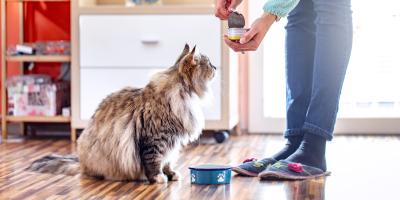
Choosing the best food for and determining how to feed a large breed dog can be difficult. Your large breed dog may have a mammoth appetite, but is bigger always better when it comes to meals for your canine?
The truth is that feeding a large breed dog is all about balance because less can sometimes mean more, at least from a nutritional standpoint. Keep in mind that large breeds are those weighing more than 56 pounds as adults. Giant breeds are those that weigh more than 75 pounds when they reach adulthood. Finding the right balance and giving your big dog the right food are both key in keeping their nutrition on point and up to par.
The Slower Metabolism of the Large Breed Dog
Sure, your big dog has an oversized appetite, but their metabolism is generally slower than that of smaller dogs. This means that to maintain a lean body and optimal health, the big breed dog needs less fat and fewer calories than the smaller dog.
However, the bigger dog’s powerful joints and oversized skeletal system both require development and support, including added nutritional support.
When it comes to feeding large breed dogs, remember that overfeeding doesn't do the large or giant dog any favours. In fact, the opposite is true. Large and giant breeds can develop the same health problems that all dogs develop when they eat too much. In addition, they are also susceptible to deformities, particularly in young, still-developing canines. Thus, when feeding large breed dogs, overfeeding your dog is never a good thing.
Choosing the Right Dog Food for Large Breed Dogs
The food you feed your large or giant breed dog is an important decision that can have a measurable impact on your animal’s health. Be sure to search for a large breed dog food with minerals such as phosphorus and calcium to help see to the added nutritional needs of the big dog.
Specialized dog food for the large breed dog that is formulated with an appropriate ratio of fat to protein can take the guesswork out of helping your large breed dog maintain a lean body mass. Selecting one with added natural glucosamine can help with healthy joints, mobility and strong bone development. Poultry and meat are sources for glucosamine, which is also a building block for the cartilage that helps with the wear and tear experienced by your dog’s joints and bones.
Tips for Feeding Large Breed Dogs
An adult dog from one of the larger or giant breeds should be fed one or two times each day. Senior dogs may prefer more frequent yet smaller portions, and this is especially true if you serve the dog canned dog food. Serving smaller portions can also help with larger dogs who tend to gulp down their food without chewing as they should, which can lead to gut problems.
When feeding a large breed dog, remember to:
- Serve the dog their food at room temperature. Doing so helps your dog both smell and taste the food as it should. You can warm up wet pet food in the microwave, but be careful that it's not served too hot.
- Store dry dog food in a clean, dry place. When possible, opt for bagged dog food that comes packaged in resealable bags, or keep your dog’s food in an airtight container. This seals in the aroma of the food and helps keep it fresh.
- Give your large breed dog a quiet environment to eat, free from interruptions and removed from where the household’s humans eat. Choose an area that can be cleaned with ease, such as a floor made from tile, or buy a mat that holds your dog’s feeding/water bowls. A raised or elevated dog bowl can benefit large breed dogs, particularly as they grow older since they are prone to the development of arthritis, which makes stooping and leaning to eat from a bowl on the floor a bit challenging.
- Keep others from interrupting your dog when it’s eating. The dog may perceive them as a predator out for the food in their dish, which can cause an aggressive reaction. Feed multiple dogs separately, which helps the dogs avoid fighting or bullying.
How Much Do I Need to Feed a Large Breed Dog?
Always defer to your veterinarian’s recommendations and those on your chosen dog food’s packaging when it comes to determining how much to feed your large breed dog. The goal of feeding your dog is to feed the dog enough food to keep the dog satiated and in a good, lean condition. Also, provide your dog with a bountiful supply of fresh water to drink too.
And remember, knowing how to feed a large breed dog today doesn't mean that the same goes when your large dog grows older. What you feed your large dog when they are 6 years old may be different than just a year later, which is when some breeds with shorter expected lifespans are considered seniors (age 7). Senior large breed dogs have different nutritional needs, so going with a special senior dog food made for dogs from larger breeds is a smart move.
Related articles



